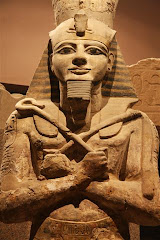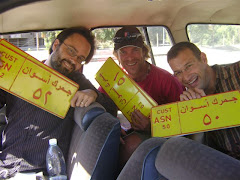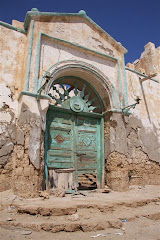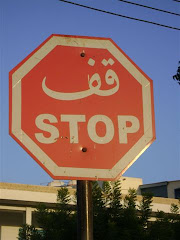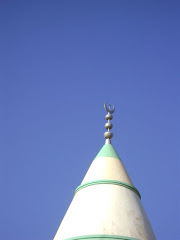Friday, 24th of October, Gonder in Ethiopia to bushcamp 30km outside Gedaref in Sudan
Happy to explore a new country, I make my way to the border town Matema on a partly tarred and mountainous road. Before I get there I almost forget to stop in Shenedi, 50 km short of Matema where according to other overlanders’ information the customs office supposed to be. That office is quite a sight and if I’d dared to, I would have taken a photo to document it! Their customs office actually looks more like a dormitory! Four string beds with mosquito nets, each one with a snoozing customs officer in them, have been put up in a way almost like to fortify the counter! Without one of them moving an inch I am told it is lunchtime and they would only open at 3 pm again! I look at my cellphone – it’s just after 1 pm now, lunchtime! What a joke! After telling them that I am still trying to make it to Khartoum today, they make me understand that the person with the key for the drawer in which the stamp is stored is gone home for lunch… but they assure me that somebody seems to have gone to call him. So I go back to my car and make myself a quick salad for lunch. After about half an hour the guy eventually arrives, only to tell me that I could proceed to the customs office in Matema! Hm, interesting! Didn’t know there is one now! He signs the letter though, that I got from the Customs and Revenue Authority in Addis.
When I arrive at customs in Matema, the customs officer in charge, again the only one that has the magic stamp to get me out of Ethiopia also seems to be on lunch in the village and a few attempts to track him down prove to be unsuccessful. So I try my luck at immigration where a young guy with quite an attitude grabs my passport and pages through a huge book with long lists of numbers to see if my passport number is blacklisted! I seem to be clean, so back to the customs office where the guy eventually turns up to stamp my carnet.
In Galabat on the Sudanese side things seem to be even more relaxed! When I arrive at the customs office, which is nothing more than a table situated in a large
shed-like building with a corrugated iron roof and a squeaky electric fan hanging from it, all what seem to be customs officers (one doesn’t really know – none of them wear any kind of uniform!) are gathered eating from one big plate of fish (it’s Friday!). Bad timing – lunchtime again! I get invited to eat with them and against my protest one guy disappears just to come back shortly after with another fried fish just for me! So with a bit of a sigh I stow my passport away again and join them at the table, reminding myself to adhere to Muslim tradition only to use my right hand for eating.
After I finish my lunch, one of the guys actually attends to my paperwork, but it turns out that the chief officer in charge who needs to sign my application is actually on some praying duty! I end up waiting 1 ½ hours for him, compelled to sip chai with the other officers! After his arrival I finally get the carnet done, get registered at immigration (130 Sudanese Pounds), recorded at the police office and only manage to leave the border after 5 pm, more than 4 hours later!
My advice to fellow overlanders: Choose any other time other than Friday lunchtime for this border crossing!
Relived having finally left the border formalities behind me, I drive on a perfect tar road into the sunset and bushcamp in a field 30 km outside Gedaref. One thing that really strikes me while I’m driving – it’s so quiet here! No children running after me, no one shouting, no one begging, no ‘You! You! You!’ So far any Sudanese person I pass is either waving friendly at me or just carrying on mining his/her own business! How awesome is that!
Saturday, 25th of October, bushcamp outside Gedaref to Khartoum
I cross the wide Blue Nile River and drive into Wad Medani where I exchange Sudanese Pounds and have yummy falafels on the side of the road. When I arrive in Khartoum I head straight for the Security Office which is actually closed – some important king has apparently passed away and a national holiday has been announced for his funeral. The same applies for the Antiquities Office where I wanted to get permits for the different archaeological sites, the German Consulate and even the National Museum, so I pop in at the Acropole Hotel to pass on best regards from Wim to the Greek owner.
The Blue Nile Sailing Club seems to be the place to meet other overlanders so I pull in there and meet a definitely different type of overlander: A guy driving from the UK to Cape Town in a white Porsche (www.africanporsche.com) busy fixing the vehicles fallen-off exhaust!!! With a permanent marker I add my signature amongst plenty of others on the fender of his vehicle and admire the 6 year old beauty, equipped with quite a different kind of rear spoiler: A ply-wood roof platform that not only unfolds serving as a base for a two-man ground tent but also has a wall-mount Heineken bottle opener screwed onto it! I park Anse at the Sailing Club and get a lift into the city center where I eat at a local restaurant and catch up with some internet.
Back at the Sailing Club I meet more overlanders, two Dutch couples who are on their way south to Cape Town. They tell me that if I was registered in Galabat, I don’t need to re-register again in Khartoum since the blue sticker that was put into the passport at the border is actually marked ‘Central Registration, Khartoum’. Yay! One less errand tomorrow! As the Porsche guy comes up in the conversation, they mention having met some London guys going south in one of these red double-decker buses!
Sunday, 26th of October, Khartoum
I go to the German Embassy where I speak to the Regional Security Officer about the current situation in Sudan after the Gilf Kebir kidnapping and specifically about the route from Port Sudan along the Red Sea Coast via Halaib to Aswan in Egypt. The Security Officer ensures me that the kidnapping was nothing for me to worry about since it occurred in the isolated far western part of the Egyptian/Sudanese border close to Chad and didn’t affect the areas I was planning to visit. He isn’t concerned about the Port Sudan-Halaib-Aswan route either but mentions that I will definitely need to apply for a travel permit going east, since I would deviate from the standard north-south Wadi Halfa - Galabat route. An area I should stay away from he advises is Kassala close to the Eritrea border where several people have been killed during demonstrations last week.
To find out more about the Port Sudan-Halaib-Aswan route I go to the Egyptian Consulate from where I was sent to the Egyptian Embassy where I was told that they can’t help me and sent me back to the Consulate! In brief, I completely wasted my time and got no information!
To bear the heat I have a refreshing ice cold carcade (hibiscus) tea served out of a bucket by a street vendor and then sit down at a local ‘ful’ place where they serve the common bean dish with plenty of oil, hot sauce and cheese sprinkled on top and accompanied with two flat pita breads. After the meal I have my first Sudanese coffee, served by one of the ladies who one can find on almost every street corner. Their utensils seldom consist of more than a handful of stools, some pots, water containers and a tiny stove. They are masters in their trade and it’s fascinating to watch them juggle an array of coffee and tea pots on their charcoal stoves, adding to the brew depending on the client’s preferences, herbs and spicy condiments taken out of a multitude of jars that surround them.
A traditionally served Sudanese coffee comes in a little clay carafe with an elongated neck and a bulb-shaped base which rests on a little padded ring. Some form of twirled plastic wool that looks like it was part of a pot scourer gets pushed down the opening of the neck before pouring the thick coffee into a small china cup, holding back the gritty bits. After adding heaps of sugar the tiny spoon gets rinsed in a separate cup specifically filled with hot water for that purpose. A tiny incense burner spreads the distinctive smell of sandal wood and myrrh. Enjoyed sweet and black, the strong and always freshly roasted spice-infused coffee is rather intoxicating!
Replenished I try my luck at the Antiquities Office again but find out that the permits for archaeological sites are no longer issued centrally in Khartoum and can now be bought at each individual site!
During my visit of the interesting National Museum I am amazed about the artefacts’ Egyptian influence and also learn about the ruined village Suakin south of Port Sudan. I park off at the Rivera Restaurant’s terrace near Omdurman, enjoying an obviously non-alcoholic sundowner and dinner overlooking the Nile
Monday, 27th of October, Khartoum
As I am intrigued about the Red Sea coast and Port Sudan/Suakin, keen to find out more about the road up north from there to Aswan but at the same time also not so sure how difficult it would be to get a travel permit for that area, I decide to make my route choice dependant on how soon I would be able to obtain it. The security office has moved and it takes me a while to find its new location where I apply for the travel permit to Port Sudan. After making numerous copies up the road I submit my application from which the officers erase Halaib saying I should apply for there from Port Sudan. I get told I can collect it tomorrow – and there doesn’t seem to be any cost involved!
I explore the souqs of Omdurman, huge bustling markets with anything on sale one can think of. I meet a friendly local guy who turns out to be working for the American Embassy and invites me for okra (a vegetable which turns pretty slimy when cooked) and tea. I give him a lift back to Khartoum where I hang out with the Dutch overlanders at the Blue Nile Sailing Club.
Tuesday, 28th of October, Khartoum to bushcamp 110 km northeast of Khartoum
I do some emailing, back up my photos that pile up in my cameras, in the afternoon fetch the travel permit from the Security Office (Granted! That was easy enough!) and then check out the big and overpriced Afra Shopping Center before hitting the road and bushcamping 110 km northeast of Khartoum.
Wednesday, 29th of October bushcamp northeast of Khartoum to bushcamp with the Bedouins 100 km east of Atbara
Exploring the Temples of Naqa, namely the Lion Temple, the Temple of Amun and the Great Enclosure is great fun as they can only be reached by driving east off the tar road through the desert. I am glad that Priscilla is behaving as she guides me with confidence through the maze of tracks!
After a ‘ful’ pit-stop in a small village called Kabushiya I carry on to the Royal Cemetery of Meroe, where I explore the famous pyramids on camel back. After filling up in Atbara I turn onto the newly tarred Atbara – Port Sudan road.
I drive another 100 km east through seemingly endless desert and when the sun starts sinking towards the horizon I pull in, after asking for their approval, to bushcamp next to several Bedouin families who have erected their big tents at a distance from each other not far from the road. It boggles my mind how people can have an existence in this landscape that looks anything else but hospitable and am intrigued how they live.
They are as curious towards me as I am towards them. The gathering crowd watches my every move when I pitch my rooftop tent and letting them inspect it after it’s up creates big amusement! I get invited to their tent, this is so exciting! Their tents are very wide and open on the side facing away from the wind. It’s comfy with carpets and pillows everywhere. Everybody sits or lies down with me and I get offered delicious coffee. Apart from the essentials my Arabic is virtually non-existent and even after consulting my little phrase book I struggle to make conversation with them, so we try talking with hands and feet which ends up to be quite frustrating after a while! One of the men gives me his cell phone to charge – I am even surprised that there is coverage here in this desolate area! Later, after I’d given it fully charged back to him, it rings and for the next half an hour or so I watch the person on the other end of the phone being handed to every single person in the tent (even the kids) making loud and leeengthy conversations.
In the darkness of the night one little girl pulls one of the grazing goats towards the tent and the covered up mother sits down next to the goat to milk it. Some of the milk gets mixed with whatever is cooking in the big pot on the fire and the rest of it gets poured into several plastic bottles. A big pot of food gets handed over to the children who walk away with it and gather to eat outside the tent. Once they are finished I get served a big plate of hard to define food. Not quite sure what to expect and a bit worried having experienced the awful tasting piece of bread in Tiya, I cautiously try a small mouthful of the food in front of me while all Bedouins’ eyes in the tent are glued on me! Phew, I am relieved – it is actually very tasty! And the crowd is all smiles that I like it! It is a kind of coarse, brownish looking porridge, similar to maize pap but made of what I think is millet. It is topped with curdled goat’s milk which might sound gross but is actually quite yum and goes well together with the dryish millet pap. To thank them for their hospitality I pull out a big packet of chocolate biscuits that we all share amongst us.
Thursday, 30th of October, bushcamp with the Bedouins to bushcamp with the truckers in Port Sudan
I am up with the sun and wave the Bedouins goodbye. I ask the family father if I could take some photographs, but he doesn’t want to, which I respect. I am a bit sad that I won’t be able to share their beautiful faces with anybody, especially the ones of their gorgeous children! But I feel privileged that I was able to get a glimpse of their way of life that is so far removed from ours!
As I drive away I see one of the men walking past the goats towards the open desert. I wonder where he’s walking to and eventually make out a herd of camels far away on the horizon!
After a few more hours of endless road through vast desert landscape and past oncoming trucks carrying container loads of goods from Port Sudan, the road suddenly turns left and winds through a rugged mountain range, only to then carry on as straight again as before all the way to the coast! But then, after having driven through almost 500 km of dry and hostile environment, the sight of the vibrant turquoise waters of the Red Sea lapping on the beaches of Suakin is truly overwhelming! I visit the ruined remains that are left of what must have once been a bustling town of Suakin built that time entirely from coral bricks on a small peninsular south of Port Sudan. I enjoy freshly grilled catch of the day at the nearby seafood restaurant which also offers good views of Suakin and the ferry terminal from which ships leave to Jeddah in Saudi Arabia, only 330 km from here!
Half an hour further north along the coast is Port Sudan, a busy town with a big commercial port. At the Hilton Hotel I try to find out more information about diving, but the diving operators that (according to the Bradt guide) had an office here closed their business two years ago. The hotel’s helpful security guard speaks good English and gives me phone numbers of two skippers/dive masters who might be able to help me. After checking my mails I try to find a hotel that would allow me to camp but most of them don’t have a courtyard, never mind secure parking! Frustrated I quit looking for a hotel and instead search for a possible bushcamping spot. Not so easy to find in a bigger town, but eventually I end up pitching my tent in a quiet street of the harbor next to truckers who spend their night on string beds beside their tanker trucks…
Friday, 31st of October, Port Sudan
One of the guys I called about diving gets back to me, but he is expecting a whole group booked onto a live-aboard diving excursion and is too busy preparing for them. He says that these types of excursions are the most common ones around here and finding day dives from Port Sudan won’t be easy.
Adamant to find out about the route north to Aswan I visit the local security office where I fill in the application form for the travel permit. Since it is Friday, the Commanding Officer in charge needs to get called and arrives half an hour later. I explain to him my intention and he claims that there shouldn’t be a problem as long as I have a valid travel permit. Somehow this all seems way too easy to me and I ask him if he possibly knows any spokesperson located near the border town Halaib that he could call to find out further information. For a while he browses through the contacts of his mobile phone and eventually calls a number. The conversation that follows seems to surprise him, so before he puts down the phone I can already tell that my route north won’t be going via Halaib! He sums up what he heard from his colleague: It seems like there is no real problem from the Sudanese side. The Egyptian Government however is very protective over tourists visiting their country and even though commercial and local traffic crosses into Egypt that way, it prohibits any foreigners from traveling this route. The main reason for this is that the former Sudanese town of Halaib, has been claimed by Egypt and is now disputed territory.
After all the mostly positive feedbacks I got until now I am just glad to find out the proper story here and not only 300 km further north!
When I ask the Security Officer about diving in the area he recommends going to Aruz 50 km up the coast and promptly issues me a travel permit for there. Before I follow his recommendation I head to the local souq where I get myself one of these long gowns that all the men wear here and have loads of fun with the tailors who for a few moments dress me up like a real Nubian – turban and all!
I drive up the sand blasted coast hoping to somehow find an opportunity for a dive – to no avail! All I find is the ‘Sudan Red Sea Resort’ which supposed to offer diving and snorkeling but whose owners are currently not around and a few km further north which supposedly is Aruz, I find a currently closed resort. Nonetheless I can’t resist the warm turquoise water, drive down to the beach, hop into my newly acquired outfit to make sure I don’t offend anybody (not that there were many people around to offend, but I wanted to be safe!) and leap into the Red Sea.
I meet three young fishermen, who seem to live on the beach close by and have set up their ‘camp’ there which merely consists of a huge cool box containing an ice block to preserve their catch, two plastic canisters of water, a pot and some basic utensils, all of it scattered around an area encircled by shells that looks like it is used for praying. They invite me over for a coffee and when I look at how they exist, it makes me realize in how much excess I actually live, even though my possessions are currently confined to a car! I drive back the sand blown road to Port Sudan and camp again with my trucker buddies ;-)
Saturday, 1st of November, Port Sudan to bushcamp next to Atbara-Karima tar road
I can’t resist another plunge into the turquoise waters of the Red Sea before heading through the desert back to Atbara where I manage to fill up water at the local market and take the ferry to cross to the western bank of the nile. Surprised to find a perfect new tar road, I make good headway and bushcamp in the desert not far from the road, 60 km short of Karima.
Sunday, November 23, 2008
Subscribe to:
Comments (Atom)



















































